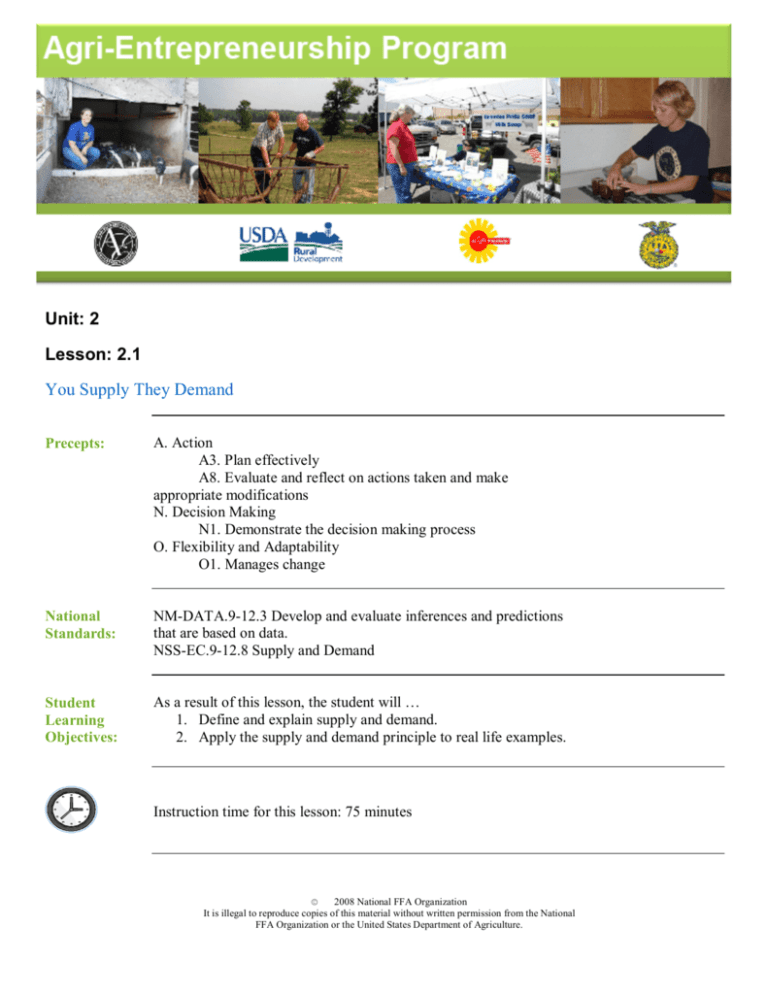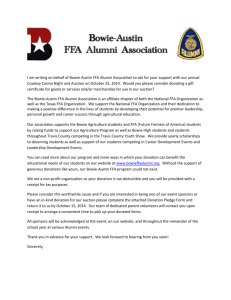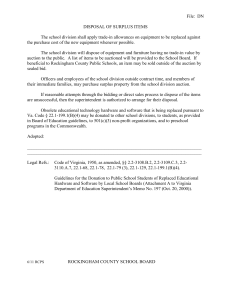
Unit: 2
Lesson: 2.1
You Supply They Demand
Precepts:
A. Action
A3. Plan effectively
A8. Evaluate and reflect on actions taken and make
appropriate modifications
N. Decision Making
N1. Demonstrate the decision making process
O. Flexibility and Adaptability
O1. Manages change
National
Standards:
NM-DATA.9-12.3 Develop and evaluate inferences and predictions
that are based on data.
NSS-EC.9-12.8 Supply and Demand
Student
Learning
Objectives:
As a result of this lesson, the student will …
1. Define and explain supply and demand.
2. Apply the supply and demand principle to real life examples.
Instruction time for this lesson: 75 minutes
©
2008 National FFA Organization
It is illegal to reproduce copies of this material without written permission from the National
FFA Organization or the United States Department of Agriculture.
Resources:
•
•
•
•
Tools,
Equipment,
and Supplies:
National FFA Organization, LifeKnowledge® materials, 2008
Gibson, J., Usry, R., Hass, L., Liles, R. & Moore, G.
Agribusiness: Management, Marketing, Human Resource
Development, Communication, & Technology. Danville,
Illinois. Interstate Publishers, Inc., 2001.
Elliot, J., Agribusiness: Decisions & Dollars. Albany, New
York. Delmar Publishers, 1998.
Mariotti, S. Entrepreneurship: Starting and operating a small
business. Upper Saddle River, New Jersey. Pearson Prentice
Hall, 2007.
Something of value that each student would want to have.
(Must have enough of these for each student in the class.
Examples include candy, trinkets, a photo of a new product
students would be interested in, etc.)
Tokens, multiple colors of poker chips or play money to use in
the auction with students.
Copies of the Lesson Assessment and AS.1 for each student.
One copy of TM.1 as a transparency or one copy for each
student as a handout.
Key Terms:
The following terms are presented in this lesson and appear in bold
italics:
Supply
Demand
Interest
Approach:
Students will be given a box of tokens, poker chips of at least two
different colors and asked to select any number of them from one to a
handful. If using play money, randomly pass out money in different
quantities to different students. Place a value on the tokens or use the
given value on money. (Make certain this is done AFTER students
have already selected their tokens.)
Welcome to class students. How many of you have ever been to an
auction?
If students have not been to an auction, describe the action and
excitement present.
Did you have fun? Did you ever want to raise your hand and feel the
adrenaline rush through your veins and have your heart beating fast,
knowing that you might get the item if someone else doesn’t bid
again? Well, today we are going to participate in a class auction.
Everyone must participate and the only way to receive an “A” today
for your class work is for you to have this item purchased by the end
of the hour.
Pull out an object that students would like to have and let the students
know that they will only receive an "A" on today’s activities if they
obtain this selected item. You will announce the bidding to open at a
random predetermined amount and they may use their tokens or
money to purchase the item.
I have just one of these items and whoever has this at the end of the
hour will receive an “A” for today’s work. Are you ready to have an
auction? Well let’s begin.
Continue auction until a student has bid the highest price for this item
and obtained it. Then pull out a large supply of the same item that just
sold while announcing that you do just happen to have a few more of
these items. Tell the students you're willing to open the bidding at an
extremely low amount. WAIT & WATCH THEIR REACTION!
After watching and hearing their comments, begin a discussion on
how they felt when they didn’t have enough money to purchase the
item to get an “A.”
How did you feel when you didn’t have enough money to purchase
the item? Why?
Solicit answers
In our last lesson we learned about the advantages and disadvantages
of being an entrepreneur and the meaning of risk. The activity we just
completed leads us into what we will be talking about today. Supply
and Demand! So, be ready to participate and apply concepts to
supply and demand.
Write supply and demand on board. Ask the individual who bought
the overpriced item to 1) define what these terms mean to him in light
of the experience he just had, 2) explain why he was motivated to pay
such a high price for it, and 3) let us know if he would have paid so
much had he known there were additional items for everyone.
Objective 1:
Define and explain supply and demand.
After completing the auction activity, the students will switch gears
and plot information on the worksheet that is to be handed out (AS.1).
Don’t explain any of the terms; just pass out the worksheet, read the
instruction aloud to the class, and ask for questions. Then give them
three to five minutes to complete the graph and think of how they
might answer the two questions at the end of the worksheet.
Good work students. Thank you so much for participating and
interacting with the activity. Now we are going to switch gears and go
from participating in the supply and demand cycle to looking at it on a
graph having data plotted on it. After I distribute this activity sheet,
we will read the directions together and then take three to five minutes
to complete it. Think how you might answer the two questions at the
end. What questions do you have?
Distribute AS.1 and read the instructions aloud.
What questions are there before we begin? You may begin.
Allow three to five minutes to complete the worksheet. After the class
has finished go ahead and begin the discussion of supply and demand
and capture the definitions of both.
Excellent work students! Who will be the first to define the two terms
- supply and demand? (Solicit some answers from students and praise
them for giving their definition.) Those were very thoughtful answers.
Let’s capture this formal definition so that we all have the same
answer.
Supply – the amount of product that a producer is willing and able to
sell at a specified price
Demand – the amount of product that a buyer is willing and able to
buy at a specified price
As we can see in our definitions, supply and demand shows the
relationships between a product’s accessibility and the interest shown
in it by the consumer.
Use the activity sheet to help guide students through the supply and
demand theory. Explain that where supply and demand intersects is
where the price is set and the amount sold is set.
At this point, have students write a short story incorporating the
definitions of supply and demand using the Dickens Moment. The
Dickens Moment taps into students’ abilities to write and tell stories.
Students review components or sections of information and think of a
story they could tell others using that information. The information
can be transformed into characters that interact, solve challenges,
dialogue, etc. Challenge students to be creative and to show they can
use the information in a different way than was presented to them.
Let us now switch gears. In a moment, when you are asked to begin,
you will have an opportunity to be creative by generating a small twoparagraph story using the terms supply and demand as our characters.
It can be funny or serious--just use the components of the definitions
to help create the story. You will have 10 minutes to write this short
story. No novels, just a short story. Who will explain the directions for
this task to the class? You may begin.
At the end of ten minutes, allow three students volunteer and read
their story.
Creative writing time is up. Who will be the first to read their short
story to the class?
Thank you.
Objective 2:
Objective 2: Apply the supply and demand principle to real life
examples.
Pass out TM.1 or display it where everyone can see.
Great stories! Now that we have an idea of what supply and demand
is, let’s look at (TM.1) how three different companies’ could sell the
same product at different prices and quantities and how this affects the
profit they will make.
Go through TM.1 with students and explain the prices and quantities
sold. Examine how the first company sold all that they were putting in
the store but weren’t making any profit due to the selling price. Most
important is to have students reflect on how they face supply and
demand on a daily basis.
Review/
Summary:
Use a modified Little Professor Moment to review. The Little
Professor e-Moment allows students to teach one another as you
guide them. When we teach something we tend to learn it better.
During the Little Professor Moment, portions of the content are taught
to half the students at a time. Then, students take turns being “Little
Professors” to their partners.
Great class today students. Here is how we will wrap up. When I say,
“Go,” pair up with someone and explain what supply is and then
switch and let your partner explain what demand is. Go!
Application:
Extended classroom activity:
Have students break into pairs and develop a new product.
Have them do a product research analysis and ask 10 people if
they would be willing to buy their new product for their price.
Answer the following questions: 1. Is the product desirable? 2.
Does the product have an appropriate price? 3. Can we make
it affordable and be able to make a profit?
FFA activity:
Students conduct a project with a current fundraising product
to determine if they think they have maxed out their demand
for the product being sold. Students could do this a variety of
ways; conducting a survey or comparing their prices to others
selling the same product to see if they are appropriately
priced.
SAE activity:
Individual students look at their SAEs or potential new SAEs
and research if there is a demand for their product and if they
could make a profit at the price at which the demand and
supply would reach equilibrium.
Evaluation:
Quiz – Lesson Assessment; Assess.1
Answers to
Evaluation:
Answers to essay questions may vary but each student’s answer
should have the concept of the given definition in class.
1. Supply is the amount of product that a producer is willing and
able to sell at a specified price.
2. Demand is the amount of product that a buyer is willing and
able to buy at a specified price.
Answers will vary greatly but the idea to get from the students is
anything that affects the supply or demand will affect how much is
sold, at what price it is sold and the quantity available.
Lesson 2.1
Assess.1
Name
Supply & Demand Quiz
Assessment 2.1
Define supply.
Define demand.
List some conditions that would change supply and demand.
Lesson 2.1
AS.1
Name
2.1 Activity Sheet 1 - Supply and Demand Introduction
Riley’s clothing store wants to set a price for a new pair of jeans. Help Riley find the best price that will satisfy
both customers and Riley.
1. Plot the points for selling price and number supplied on the graph below. Draw a line through these points
and mark the line "Supply".
2. Plot the points for selling price and number demanded. Draw a line through these points and mark the line
"Demand".
3. Estimate where supply and demand are equal (in equilibrium). Circle this point and identify the selling price
and units sold.
Selling
Price
Number Supplied
Number
Demanded
$10.00
17
496
$20.00
$30.00
$40.00
$50.00
134
251
368
485
392
288
184
80
Question:
1. From the activity above, how would you define supply and demand in your own words?
Lesson 2.1
TM.1
Name
Transparency Master 1
Comparison of Three Companies’ Prices and Quantities Sold
Company A
Price : $5.50
Quantity sold – 1000
Profit margin -$.10
Company B
Price $12.50
Quantity sold – 425
Profit margin - $4.10
Company C
Price – $25
Quantity sold – 10
Profit margin - $17.75
Which company could continue to sell their product and continue to make a profit for a long period of time?
(Answer Company B)
Why do you think so students? (Solicit some answers)
Which company over priced their product? What affect did this have on the quantity sold? Why?
Which company sold a large quantity? Why would this business not be able to continue to produce this product
if the cost went up $.20?
What are examples of how you face supply and demand on a daily basis?









